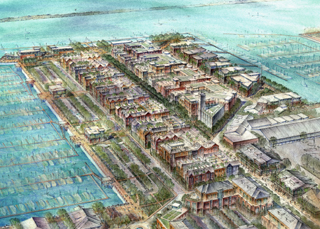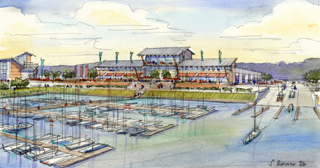
DJC.COM
September 25, 2008
Great civic developments need private know-how
David Evans and Associates

Olsen
|
The waters and shorelines of the Puget Sound region have deeply influenced its culture. Water is central to our way of being and key to our future, both in the built and natural worlds.
Waterfronts offer many amenities, both natural and man-made, but they are also under great pressure as cultural, natural and economic resources. They offer opportunities to reverse past environmental damage through new public policies that support economic revitalization.
Revitalization can have a positive impact on local economies, communities and the environment. As developments evolve, partnerships between private and public entities can enhance these positive impacts. Two recent waterfront redevelopment projects in the Puget Sound region offer concrete examples:
Port Gardner Wharf
The Port Gardner Wharf project in Everett shows how the local community benefits from waterfront redevelopment.

Image courtesy of Maritime Trust Co./MacDonald Studio The city of Everett anticipates Port Gardner Wharf will generate 1,800 jobs and $1.9 million in annual tax revenue when completed. |
The first major goal of the public-private partnering team (the Port of Everett and the Maritime Trust Co.) was to mitigate economic impacts to existing businesses that would be displaced. These efforts were so successful that, after the redevelopment was completed, the great majority of the existing area jobs (many that were not water dependent) were retained in Everett or within Snohomish County. Of special note, the boat repair and marine retail firms were retained in the redevelopment’s new Craftsmen District.
The team’s second goal was to enhance economic opportunities and benefits for the community. Once the redevelopment has been completed, community leaders anticipate a number of positive economic impacts for the area, including:
• Increased employment by more than 1,800 direct jobs;
• Increased payroll by $81.2 million more annually; and
• Substantial tax revenue increases for the city and county, including $1.9 million more per year for the city of Everett and nearly $500,000 more per year for Snohomish County.
The Port Gardner Wharf redevelopment program will give the community the best of both worlds: retention of most of the existing jobs and creation of a vibrant neighborhood that is a key part of the new Everett.
Waterfront District
The Port of Bellingham partnered with the city of Bellingham to create a master plan and development agreement to remake more than 200 acres of prime urban waterfront, reconnecting the city to Bellingham Bay. This new development is known as the Waterfront District.

Image by Stephanie Bower, courtesy of the Port of Bellingham The Port of Bellingham will clean up a 220-acre industrial site to spur a mixed-use redevelopment that could include parks, research labs, shops and housing. |
The property, once the site of the Georgia Pacific Tissue Mill, is poised for redevelopment following an extensive community interaction and planning effort that began in 2001 and is expected to result in adoption of a master plan during the first quarter of 2009.
The former industrial site requires significant environmental remediation work prior to private investment in the site. The in-water environmental cleanup plan has been approved by the state Department of Ecology, and engineering is under way for the multi-year cleanup. Landside cleanup sites are being evaluated now.
Recently, Western Washington University announced plans to locate its Huxley College of the Environment and other programs in the Waterfront District. This public-sector action represents the catalyst that will attract spinoff uses that will likely range from science and research, applied technologies and classroom-to-market incubators to retail, residential and hospitality uses.
The transformation of an underutilized brownfield to viable educational, residential, commercial and recreational uses represents an economic and cultural rebirth for the community.
Spinoff development adjacent to the university will create a vibrant base for jobs and deliver millions of dollars in tax revenues to the city, while the public-private partnership will assure a balanced approach to development of both economic uses and public open space and recreation.
There are seven state-listed cleanup sites within the district. The port has acquired most of the contaminated property and taken over responsibility for the cleanup, which it expects to cost more than $85 million. The state will help with the funding. As the property is cleaned up to meet state standards, the port will sell or lease the property for redevelopment to recoup the port’s expenses.
The net result will be a waterfront that will attract private-sector investment, reconnect the city and its waterfront, and have environmental stewardship as a central feature of the development.
The site has also been selected as a pilot project in the U.S. Green Building Council’s LEED for Neighborhood Development program and will feature compact urban development, walkable streets, a network of parks, open space and bicycle trails, shoreline bank restoration and a “clean ocean” marina.
Partnership benefits
This blending of the talents and capabilities of both private and public sectors can create a team that fully utilizes all the required resources for a successful outcome.
Dividing and distributing the labor to the right talents on the team allows for the most effective application of effort. Additionally, the blending of bonding capacity with private financing creates a more focused funding stream for project elements and shares the risk across a broader market.
Most important, however, are the checks and balances that produce truly great civic development. The public sector is involved through its “agent,” who is an advocate throughout the process for those things typically seen as “extras” by the private side. Thus the public domain of open space, access, art, civic functions and environmental stewardship are equally prominent in the project decision-making matrix.
At the same time, the private sector acts as an advocate for project profitability in which both entities share. The design and delivery of a product that meets market needs, financing requirements and is delivered within the time frame of a positive market is a delicate balancing act requiring equal portions of agility and power, which is not conducive to oversight by commissions or governing bodies.
Shared accountability and responsible actions by dedicated teams of private and public sector entities can lead to results that fulfill the dreams of our water-edge culture.
Ken Olsen is a land development client manager with David Evans and Associates. The Port of Bellingham contributed to the article.
Other Stories:
- Put mixed uses where they belong — by the water
- 5 principles for renewing Seattle’s waterfront
- Group efforts make for better shorelines
- Seattle’s waterfront a showcase of lost opportunities
- Competing goals drive Anacortes marina project
- Redevelopment: fraught with challenges, but worth the plunge
Copyright ©2009 Seattle Daily Journal and DJC.COM.
Comments? Questions? Contact us.